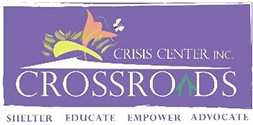Help is available. Contact Crossroads today.
Advice To Keep You And Your Family Safe
You cannot control abusive behavior, but you can take steps to protect yourself, your children and your family from harm. We offer this safety advice for your home, your work, your vehicle, public places and more. When you are ready to leave, Crossroads Crisis Center is here to help 24/7 at 419-228-HELP. If you are in immediate danger, dial 9-1-1.

Checklist
What I Need to Take When I Leave: Be prepared. Have these items or copies of these items already gathered and/or in a place outside of the home. DO NOT STAY TO GET THEM AT THE TIME OF THE INCIDENT. NOTHING IS MORE VALUABLE THAN YOUR LIFE. Everything can be replaced or retrieved at a later time.
Driver’s license or State ID
Car title & registration
Marriage license
Protection Order
Lease and/or House Agreements
Checkbook, bank book, & withdraw slips
Health insurance or medical card
Medical/Vaccination records
A change of clothes for self and children
Children’s small toys, blankets, etc.
Write down partner’s SS & DOB
Military ID cards for self and children
Green card & immigration papers
Welfare identification
Passport for self and children
Community resource numbers
Divorce papers, including custody & visitation orders
Children’s birth certificates
Your birth certificate
Money & credit/debit cards
Insurance papers
Medications
Address book
House and car keys
Social Security cards
Safety plan
Child support order
Pictures (family photos)
Small objects to sell
Jewelry
School records
Work permits
Pets (if you can)
Safety At Home
- Try to always keep a phone nearby. Sometimes a defunct cell phone will still be able to call 911. In order for the phone to call 911, it has to have a working signal and a charged battery. It does not have to have a contract with a carrier.
- Plan what your children should do in a violent situation. Where should they go, a room in the house, a neighbor’s house, or a spot down the street, etc. Decide if you want them to call 911 and if so, show them how.
- Talk with someone that you trust. Develop a code word or signal with a friend or family member.
- Keep a bag packed and hidden in a safe place or at home in case the abuse escalates.
If the abuse escalates and you are in danger
- Keep your phone with you.
- Know numbers to call for help.
- Use your instincts and judgment. Do what you need to do to stay safe, this could mean doing what your partner wants.
Safety During An Incident
- The time of the incident is not the time to reason with the offender. You cannot make sense out of a senseless situation. Now is not the time to reason or rationalize. If at all possible, leave and/or get to a safe place.
- If an incident is unavoidable, try to have it in a room or area with an exit and not in the bathroom, kitchen, garage, or anywhere near weapons.
- Practice how to get out of your home safely. Identify which doors, windows, elevators,s or stairs would be best.
- Identify one or more neighbors you can tell about the violence and ask that they call the police if they hear a disturbance coming from your home.
- If the situation is very dangerous, use your own instincts and judgments to keep yourself safe. Consider giving the abuser what they want to calm them down to protect yourself until you are out of danger.
- Dial 911 as soon as it is safe to do so.
- Seek medical treatment if injured by the abuser. Make sure medical personnel or law enforcement personnel photograph all injuries.
Safety At Court Or Public Places
- If at all possible, arrange for someone to go with you for support and safety.
- Wait in a safe place if your abuser is nearby, such as next to a security guard or bailiff in court.
- Sit at a physical distance from the abuser and their family members. Always make sure other people are in between you and the abuser.
- Make certain that you are safe when you leave a courthouse or a public place. Abusers often stalk victims to discover where they live, or to punish victims for taking legal action. Arrange to go directly from the court to a friend or relative’s house so that you will not be alone in the event that you are being followed, or not leading them straight to your residence.
- You can also ask court personnel to escort you to your vehicle.
Safety At Work
- If you feel it is safe to let your employer know, inform the supervisor of the potential for abuse as soon as possible.
- If you cannot talk to your supervisor, check your company’s domestic violence policy to identify the person with whom you should speak with.
- If you feel it is safe to do so, provide the employer with enough information to take advantage of all resources available.
- Give a picture of the abuser and the abuser’s vehicle to security guards and colleagues at the workplace. If the abuser shows up, security or other workplace personnel can order the abuser to leave or call the police.
- If you have a protection order keep a copy of your protection order at work. Notify a supervisor or the Human Resources Department of the existence of the order and give them a copy.
- Inform supervisor of abuse that occurs via work telephone.
- Have your calls, visitors, mail, and packages screened. Screen calls with voice-mail or a machine if possible, or ask a receptionist or a colleague to screen calls. Do not accept packages you didn’t order or do not recognize.
- Keep emergency contact information up to date. Make sure your employer and all receptionists know it’s unlisted and that your telephone number and address are not to be given to anyone.
- Keep lines of communication open even during extended time off.
- Travel to or from work with another person. If your name is on a reserved space, have it removed. Be alert to anyone watching or following you on foot or by car. Never walk to your car alone.
- Leave the building with others if possible.
Vehicle Security
These are important safety tips after leaving an abusive relationship.
- Park in a well-lit area.
- When parking in your garage, try to keep lights on and always lock your car and garage doors.
- Always check the back and front passenger areas before getting
- Be alert for vehicles that appear to be following you. If you believe you are being followed, drive to the nearest police station or fire station and sound the horn for attention. If this isn’t easily accessible, drive to a heavily populated area such as a mall. Plan ahead to know where these places are located.
- Do not use predictable schedules and/or routes.
Safety Planning With Technology
The link below will take you to a Technology Safety Plan, Guide for Survivors and Advocates.
https://www.techsafety.org/resources-survivors/technology-safety-plan
